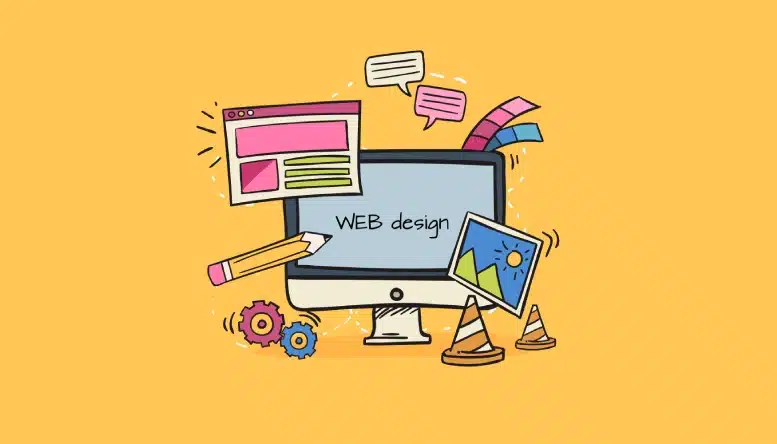Why Businesses Are Investing in Web Design Johannesburg for Higher Conversions
The Important Aspects of Efficient Website Design: A Comprehensive Overview
Reliable web Design encompasses various crucial components that substantially effect user experience. It demands mindful factor to consider of elements such as mobile responsiveness, user-friendly navigating, and visual power structure. Each part plays a necessary function in crafting a site that not just attracts site visitors yet additionally retains them. Understanding these fundamental elements is important for companies intending to enhance their online existence. What truly distinguishes an effective website from its rivals?
Comprehending Individual Experience (UX) Design
User experience (UX) Design acts as the foundation of reliable web Design, concentrating on exactly how customers interact with a website. It incorporates different elements, including usability, accessibility, and general fulfillment. A successful UX Design starts with individual research study, determining the target audience's needs and actions. Models and wireframes are then developed to picture the web site's structure and circulation. Seo Company Klerksdorp. Testing with genuine users gives beneficial understandings, permitting developers to fine-tune the user interface and enhance navigating. Visual Design components, such as typography and color design, boost the total visual while supporting capability. Ultimately, effective UX Design guarantees that individuals can easily complete their goals, fostering involvement and commitment. By focusing on user experience, sites can attain greater conversion rates and a favorable credibility
Relevance of Mobile Responsiveness
As smart phones significantly control web use, making sure mobile responsiveness has actually come to be necessary for reliable website design. Web sites that are not optimized for mobile can cause an inadequate user experience, resulting in greater bounce prices and lost chances. A mobile-responsive Design allows web content to adapt seamlessly to different display dimensions, ensuring that individuals can access details conveniently, no matter of the tool they use. Additionally, online search engine focus on mobile-friendly web sites in their rankings, making responsiveness an important factor for presence and website traffic. With a growing variety of individuals accessing the web via tablet computers and smart devices, businesses have to purchase mobile responsiveness to improve individual interaction, boost brand assumption, and inevitably drive conversions. Reliable web Design need to prioritize mobile responsiveness to remain competitive in today's digital landscape.
Crafting Instinctive Navigating
Navigation offers as the foundation of any kind of effective web site, assisting site visitors via web content with simplicity. An user-friendly navigation structure improves individual experience by allowing users to locate details promptly and efficiently. Clear labeling of menu things is crucial; it must reflect the content properly, avoiding jargon that might confuse customers. Furthermore, a sensible pecking order is vital, allowing individuals to determine relationships between various areas. Consistency across web pages helps reinforce assumptions, while breadcrumbs supply context and a sense of instructions. Responsive navigation food selections that adapt to various gadgets even more boost ease of access. Inevitably, the goal is to develop a seamless trip for site visitors, guaranteeing they can explore the website without aggravation, resulting in an extra engaged and pleased target market.
Making Use Of Aesthetic Pecking Order
Aesthetic power structure plays an important duty in web Design by guiding individuals' attention and improving their experience. Efficient layout techniques, along with thoughtful selections in shade and typography, can considerably influence how info is viewed and processed. Comprehending these elements is crucial for developing aesthetically appealing and functional internet sites.
Importance of Visual Power Structure
Effective website design depends upon the idea of visual pecking order, which guides users with content in a user-friendly and sensible manner. This concept is crucial for improving customer experience, as it aids prioritize information and routes focus to essential components. By developing a clear hierarchy, internet developers can ensure that individuals quickly determine vital messages, contacts us to action, and navigating options. A well-structured visual power structure reduces cognitive tons, allowing individuals to process information efficiently. Furthermore, it fosters engagement by producing an appealing format that invites exploration. Inevitably, understanding the importance of aesthetic power structure is crucial for any type of internet designer intending to produce efficient and easy to use sites that efficiently connect their designated messages.

Techniques for Effective Layout
An efficient layout serves as the backbone of any effective website design, permitting customers to easily navigate via content. Reliable techniques consist of grid systems, which supply a structured framework for lining up aspects, guaranteeing uniformity and balance. In addition, using whitespace purposefully can enhance concentrate on essential locations, reducing visual clutter and directing customer interest. Focusing on material with dimension and placement additionally highlights important information, while different components can produce a clear aesthetic pecking order. Applying receptive Design strategies warranties formats adjust effortlessly throughout gadgets, preserving functionality. Incorporating intuitive navigating aids, such as food selections and switches, enhances user experience, making it much easier for visitors to find appropriate details rapidly. With each other, these techniques create the structure of a reliable web layout.
Color and Typography Choices
While shade and typography options may look like basic Design elements, they play a necessary function in developing visual hierarchy on an internet site (Seo Company Klerksdorp). Shade can direct customers' focus, set apart sections, and convey brand identity. By strategically making use of contrasting colors, designers can highlight crucial contact us to activity, ensuring they stand apart. Typography, on the various other hand, influences readability and customer involvement. An appropriate typeface can communicate tone and character, while varying font sizes and weights can create a clear structure. Bigger, bolder headings attract focus, while smaller sized body message provides detailed information. With each other, effective color and typography options produce a cohesive aesthetic experience, leading individuals with the material effortlessly and improving general use
Picking the Right Color Pattern
How does one select the perfect color design for a site? Choosing the best color pattern is essential for boosting user experience and sharing the brand name's message. Designers ought to start by considering the target market and the feelings that various colors evoke. For instance, blue usually signifies trust fund, while red can produce urgency. It is necessary to restrict the palette to a couple of corresponding colors to maintain aesthetic consistency and avoid overwhelming individuals. Utilizing devices like color wheel applications can aid in picking colors that function well with each other. Additionally, developers should guarantee that there is sufficient comparison in between text and background shades for readability. Ultimately, a well-balanced color pattern can substantially affect a website's performance and individual involvement.
Integrating Involving Material

Involving material is important for capturing and maintaining the attention of site site visitors. It serves as a bridge in between the website's Design and the user's experience, promoting much deeper connections. Effective material frequently consists of a mix of helpful articles, captivating visuals, and interactive elements that encourage individual engagement. By utilizing Click This Link narration methods, internet sites can evoke emotions, making the product a lot more unforgettable and relatable. In addition, incorporating user-generated web content, such as reviews or testimonies, boosts trustworthiness and constructs trust with the target market. Clear calls-to-action overview customers towards desired end results, guaranteeing they remain engaged. In general, a strategic approach to content development not just boosts customer experience but also drives conversions, making it a critical aspect of efficient web Design.
Optimizing for Speed and Performance
Enhancing for rate and efficiency is crucial for enhancing customer experience on a site. Methods such as picture compression, minifying CSS and JavaScript, and leveraging browser caching can considerably lower filling times - Web Design South Africa. These techniques not just enhance efficiency however likewise add to better search engine rankings
Image Compression Techniques

Minifying CSS and JavaScript
Numerous web developers focus on photo optimization, minifying CSS and JavaScript is equally important for improving website speed and efficiency. Minification entails getting rid of unneeded characters from code, such as whitespace, remarks, and formatting, without influencing its functionality. This procedure results in smaller sized data dimensions, which causes much faster filling times and improved customer experience. By reducing the amount of data moved between the server and the customer, minification aids decrease transmission capacity usage and improves total website efficiency. In addition, search engines prefer faster websites, which can improve search positions. Applying tools and automated procedures for minifying these scripts can simplify internet development and upkeep, making sure that efficiency remains a concern throughout the lifecycle of a website.
Leveraging Web Browser Caching
Leveraging internet browser caching greatly improves internet site speed and performance by keeping often accessed sources locally on an individual's gadget. This method minimizes the requirement for repeated requests to the server, substantially minimizing packing times for returning site visitors. By making use of HTTP headers, internet developers can define caching rules for different sources, such as manuscripts, photos, and stylesheets. Web Site Appropriately carried out caching methods enable customers to experience faster page loads, causing boosted customer fulfillment and interaction. Furthermore, search engines favor internet sites with enhanced performance, potentially improving search positions. Frequently examining and managing cache setups ensures that individuals get updated content while still taking advantage of the performance of cached sources. In conclusion, reliable web browser caching is an important part of maximizing internet efficiency.
Regularly Asked Inquiries
Exactly how Do I Pick the Right Web Design Tools?

Choosing the appropriate internet Design devices involves reviewing job demands, comprehending customer requirements, and assessing different software program attributes. Compatibility, ease of usage, and neighborhood support are likewise vital variables to take right into account for reliable Design outcomes.
What Are Typical Internet Design Blunders to Avoid?
Typical internet Design mistakes to prevent include chaotic layouts, bad navigating, inadequate mobile responsiveness, sluggish filling times, and neglecting individual experience. Efficient layouts focus on simplicity, accessibility, and functionality to involve individuals and boost fulfillment.
How Can I Measure My Site's Success?
To determine a website's success, one might assess metrics such as website traffic, conversion prices, customer interaction, and bounce prices. Making use of devices like Google Analytics can supply useful understandings for recurring optimization and renovation strategies.
What Duty Does Search Engine Optimization Play in Internet Design?
Search engine optimization significantly affects website design by guaranteeing that web sites are structured for search engine exposure. This consists of maximizing website rate, mobile responsiveness, and content quality, inevitably boosting customer experience and driving natural web traffic.
How Usually Should I Update My Internet Site Design?
The frequency of internet site Design updates relies on market patterns, user responses, and technical innovations. Typically, a refresh every 2-3 years is advisable, making certain go the site continues to be relevant and straightened with existing requirements and user assumptions.
Individual experience (UX) Design serves as the backbone of efficient web Design, concentrating on how individuals interact with a website. With an expanding number of individuals accessing the web via tablets and mobile phones, businesses need to invest in mobile responsiveness to enhance user involvement, enhance brand assumption, and eventually drive conversions. An intuitive navigating framework improves individual experience by permitting individuals to locate information quickly and effectively. Properly carried out caching strategies permit individuals to experience faster web page loads, resulting in enhanced user satisfaction and interaction. The regularity of website Design updates depends on industry patterns, customer feedback, and technological advancements.